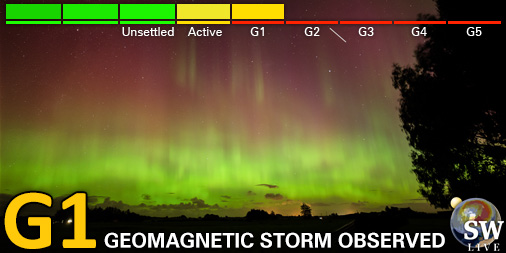Viewing archive of Thursday, 5 October 2017
Daily bulletin on solar and geomagnetic activity from the SIDC
Issued: 2017 Oct 05 1230 UTC
SIDC Forecast
Solar flares
Quiet conditions (<50% probability of C-class flares)
Geomagnetism
Quiet (A<20 and K<4)
Solar protons
Quiet
| 10cm flux | Ap | |
|---|---|---|
| 05 Oct 2017 | 086 | 009 |
| 06 Oct 2017 | 086 | 015 |
| 07 Oct 2017 | 084 | 010 |
Bulletin
Solar activity was at very low levels. The two visible sunspot groups, NOAA 2683 (Catania 57) and NOAA 2682 (Catania 56), produced 2 low- level B-class flares each. NOAA 2683 displayed a moderate size increase of some small opposite polarity sunspots south of the main spot, whereas NOAA 2682 still features a long filament to the east and north of the main spot. No earth-directed coronal mass ejections (CMEs) were observed in available coronagraphic imagery. The greater than 10 MeV proton flux was at nominal levels.
Quiet flaring conditions are expected, with a small chance on a C-class flare.
Solar wind speed varied between 360 and 380 km/s before 23UT, and between 380 and 410 km/s for the rest of the period (DSCOVR). Bz fluctuated between -6 and +7 nT, being predominantly positive after midnight. The interplanetary magnetic field was mostly directed towards the Sun.
The geomagnetic field was at quiet to unsettled levels, and is expected to remain so. The particle stream associated with a small negative equatorial coronal hole is still expected to arrive at Earth, late on 05 or on 06 October. This may increase the likelihood on an active geomagnetic episode.
Today's estimated international sunspot number (ISN): 029, based on 14 stations.Solar indices for 04 Oct 2017
| Wolf number Catania | /// |
| 10cm solar flux | 087 |
| AK Chambon La Forêt | 010 |
| AK Wingst | 007 |
| Estimated Ap | 006 |
| Estimated international sunspot number | 028 - Based on 21 stations |
Noticeable events summary
| Day | Begin | Max | End | Loc | Strength | OP | 10cm | Catania/NOAA | Radio burst types | |
|---|---|---|---|---|---|---|---|---|---|---|
| None | ||||||||||
Provided by the Solar Influences Data analysis Center© - SIDC - Processed by SpaceWeatherLive
All times in UTC
Current data suggests there is a slight possibility for aurora to appear at the following high latitude regions in the near future
Gillam, MB, Whitehorse, YT, Yellowknife, NTLatest news
Latest forum messages
Support SpaceWeatherLive.com!
A lot of people come to SpaceWeatherLive to follow the Sun's activity or if there is aurora to be seen, but with more traffic comes higher server costs. Consider a donation if you enjoy SpaceWeatherLive so we can keep the website online!

Latest alerts
Monday, 21 April 2025
20:45 UTC - Geomagnetic activity
Minor G1 geomagnetic storm (Kp5) Threshold Reached: 20:33 UTC
18:57 UTC - Solar flare
Moderate M1.99 flare
18:39 UTC - Radio Blackout
Minor R1 radio blackout in progress (≥M1 - current: M1.93)
14:00 UTC - Geomagnetic activity
Minor G1 geomagnetic storm (Kp5) Threshold Reached: 13:52 UTC
12:00 UTC - Geomagnetic activity
Minor G1 geomagnetic storm (Kp5) Threshold Reached: 11:42 UTC
Space weather facts
| Last X-flare | 2025/03/28 | X1.1 |
| Last M-flare | 2025/04/21 | M1.9 |
| Last geomagnetic storm | 2025/04/21 | Kp5+ (G1) |
| Spotless days | |
|---|---|
| Last spotless day | 2022/06/08 |
| Monthly mean Sunspot Number | |
|---|---|
| March 2025 | 134.2 -20.4 |
| April 2025 | 120 -14.2 |
| Last 30 days | 111.9 -31 |






